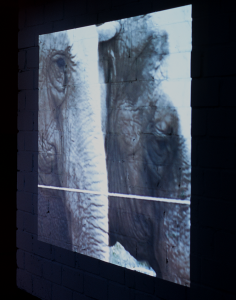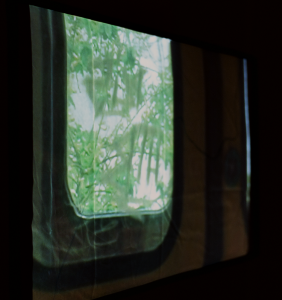April/May 2007, Berlin Germany

Untitled. Image supplied by the artist.
This was the second year that the two organisers, Miriam Mlecek and Katie Hepworth, had put on this event. Although the project took place in the first half of 2007, there had been a gradual lead up to my involvement through physical meetings in Sydney with the other Sydney-based artists and architects, and online blog discussions.
My communication with Katie and Miriam began early in the second half of 2006. Over the next nine months, it became clearer who was to participate in the residency, and very loose ideas for the work I could create, and possible partners in collaboration began to form in my head. Acquaintances between the participants were first made online, when our biographies were published on the Transit Lounge blog (http://www.transitlounge.org).
Preliminary ideas about artworks and collaborations became firmer upon meeting several other participants a number of times while we were all still in Sydney.
One of the Sydney-based architects I met during these initial meetings was Hugo Moline. After noticing many similarities between our works and conceptual concerns, we began a discussion about informal architecture and art’s place in the public sphere. This led to us collaborating on ideas in Berlin, and making plans for further collaborations beyond the Transit Lounge residency.
Over the next months, discussions and reflections between all of the participants took place on the blog. I’m sure the organisers would have liked for these discussions to have flowed more freely and numerously than they did, however, it was a daunting prospect to expose half-formed thoughts and ideas to a relatively unknown readership.
During the lead-up to my residency, I did not feel pressured to arrive in Berlin with a work already in mind and a clear conceptual path to follow. I was eager to engage with the other artists and architects there at the same time as me, and work in a collaborative manner.
When I arrived in Berlin, there were three other Australian artists already undertaking the residency: Isabelle Toland, Jasper Knight, and Jodi Rose. A Portuguese artist based in Amsterdam, named Isabel Cordeiro arrived soon afterwards.

Untitled. Image supplied by the artist.
Because exhibitions were held every fortnight, we had two weeks to conceive of and create our artworks. As a group we began discussions about how to interpret the idea of “transit”. We were all interested in exploring Berlin, and I was particularly interested in venturing out to the periphery of the old East Berlin. At the same time, we also began exploring the basement of the building complex in which the studio and gallery were located.
On one of our journeys out to the East, we came across an extremely incongruous scene. Near the suburb of Marzahn, which is notorious for its population of neo-nazi followers, we saw a herd of Elephants grazing in a field. They were flanked on one side by a busy, major road, and on the other sides by apartment buildings.
The elephants were part of a nearby circus, but when filming them, I tried my best to isolate them within the context of the apartment buildings in order to heighten the bizarreness of the situation.
I projected the resulting work inside the basement of the gallery, so that it could only be seen through windows at ground level on the outside of the building. By doing this I was experimenting with ideas about concealing and revealing misconceptions and preconceptions.
The second video installation I created for the next exhibition I was in also used the perimeter of Berlin as its subject matter. I had been thinking about how I could present the idea of “transit” physically and visually.
I travelled from one side of Berlin, an area called Ahrensfelde, also in the old East, along a single train line which runs diagonally through Berlin to the lakeside holiday destination Wannsee, located in the area which once made up the old West Berlin. I was interested in the contrast that could be noticed between these two areas that were only separated by an hour-long journey in a single direction on the one train line.
I filmed the entire journey from a fixed position looking out of the train window. When I came to edit the footage, I made the realisation that a lot of what we experience as transit is actually the waiting time in between destinations, when we are stationary.
I then edited out all of the footage taken while the train was moving, and presented a montage of the images randomly composed when the train was stopped at each of the twenty-six stations along the route. I then rear-projected this footage on to a screen I purpose-built to look like a train window. I suspended the screen in the middle of the gallery space, and I think the illusion of being a train window was quite successful.
Participating in and contributing work to the Transit Lounge residency has been an excellent opportunity for me to develop my art practice. I have found that working in such a compressed time frame made me more willing to experiment with filming and projection techniques.
Through my involvement with the residency, I have also made contact with many other artists and architects based in Australia and Europe, and I am very optimistic for the possibility of future collaborations.
Since finishing the residency, I have already been involved in putting on performance, and video installation events in Berlin with three other Melbourne-based artists, Benjamin Ducroz, Kristina Matovic and Michael Prior, and one Berlin-based sound artist, Guido Henneboehl, who were all associated with the Transit Lounge.
Tags: misconceptions and preconceptions, physical and visual transit, public space, urban environments




